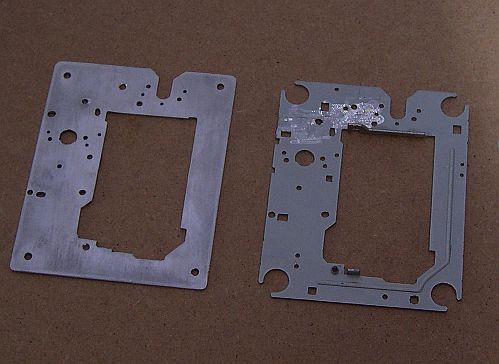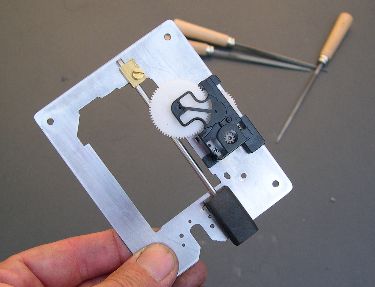Last edited:
guys,
thanks for the suggestion for for the spdif cables.
75 characteristic might be difficult to DIY from scratch.
I can vouch for BELDEN 83264 being excellent with the shiga. BNC or directly soldered though. forget about RCA connectors on spdif
Hi Igor, what interests me most is how you solved the movement of the CD platform motor - how exactly you mounted it in order to achieve both low friction and stability (vibration release) at the same time?
I understand that with a rigidly mounted lens, it is the CD platform that has to move in order for the laser to follow the track. How is it mounted? I know you mentioned it floats on an air bearing, but how it remains stable?
https://drive.google.com/file/d/0B8kj-_TTE29VYnNabHRneDE5VVU/edit?usp=sharing
https://drive.google.com/file/d/0B8kj-_TTE29VQzB6Y2NadWQ0Uzg/edit?usp=sharing
https://drive.google.com/file/d/0B8kj-_TTE29VM3BuVFBlME9Ib3M/edit?usp=sharing
https://drive.google.com/file/d/0B8kj-_TTE29VNXNKSkRuaURmWGc/edit?usp=sharing
Gravity and correct weight concentration in combination with right side cushion inclination is the key.
Hi Igor,
I know a little what you are on about by ditching the standard laserplatform.
I did it and made a new one out of RVS with an RVS laserrod and some ebony.
The results to me were just stunning...the anti-magnetics work like miracles...


I remember this enthusiastic step forward
 .When I removed steel plate on the spin motor I realized the positive effect of anti magnetism and perhaps less mass in rotation.I have only done that mode on pic for sinking the laser energy and to make the plate more rigid
.When I removed steel plate on the spin motor I realized the positive effect of anti magnetism and perhaps less mass in rotation.I have only done that mode on pic for sinking the laser energy and to make the plate more rigidhttps://drive.google.com/file/d/0B8kj-_TTE29VWjBrUW1odzBMeDg/edit?usp=sharing
and soon moved to air.
Hi guys,
Sorry to be off topic. Will you please recommend a good 75 ohm spdif cable for Diy. I'm having an itch to build one.
thanks guys
Just take any analog IC cable that you like most in your system and try it in place of actual 75ohms s/pdif cable.If you can fight a prejudice (if you have it) about 75ohms, you will be rewarded.It is only a question of quality in s/pdif transfer.The cable does not carry any ones and zeroes but electrical signal that don't want to be distorted and on the end of the route it is decoded to 1 and 0 in the receiver and there is no place for simplifications about unimportance of cable choice as some mathematics based engineers claim .
Stable mechanical construction and low dielectric constant of the insulators involved make miracles so any ptfe or pe insulator is inferior to natural ,organic ones.Of course synthetic materials if properly implemented can sound good too and that is possible in alternative designs ,not coaxial ones.In last 5 years I have made many persons happy with my cotton thread based ''s/pdif'' cables.Those persons didn't needed anything else after that.Some of them experimented with real 75ohms and analog ones and analog cables sounded always best in the systems ,less compressed ,natural and detailed depending on quality level ,of course.
Find the right sounding cable on analog source side first and then use it on transport side.75ohm is mathematics theory but our music is not.Hard wiring the s/pdif after right cable choice is made is huuuge step forward when possible.Keep in mind that bad and incomplete transfer of the s/pdif voltage make your final sound defined by this first signal cable and 75 ohms cables do that by defaulted because of it's construction handicap and are very bad for audio.Their mechanical construction is too rigid and mechanical energy is managed in analog way plus the insulator is too thick so the loss of fragile signal is inevitable.The wire inside is often too thick which is bad for high frequencies that have to carry.Maybe it is needed for radio signal amplifier voltage supply on top of the building or to not be interrupted in hot part after 100m of inside wall tubing pulling but not for our fragile s/pdif.Sorry if I bothered you but I wasn't able not to write anything seeing the theme which make me alive.
Igor
Just take any analog IC cable that you like most in your system and try it in place of actual 75ohms s/pdif cable.If you can fight a prejudice (if you have it) about 75ohms, you will be rewarded.It is only a question of quality in s/pdif transfer.The cable does not carry any ones and zeroes but electrical signal that don't want to be distorted and on the end of the route it is decoded to 1 and 0 in the receiver and there is no place for simplifications about unimportance of cable choice as some mathematics based engineers claim .
Stable mechanical construction and low dielectric constant of the insulators involved make miracles so any ptfe or pe insulator is inferior to natural ,organic ones.Of course synthetic materials if properly implemented can sound good too and that is possible in alternative designs ,not coaxial ones.In last 5 years I have made many persons happy with my cotton thread based ''s/pdif'' cables.Those persons didn't needed anything else after that.Some of them experimented with real 75ohms and analog ones and analog cables sounded always best in the systems ,less compressed ,natural and detailed depending on quality level ,of course.
Find the right sounding cable on analog source side first and then use it on transport side.75ohm is mathematics theory but our music is not.Hard wiring the s/pdif after right cable choice is made is huuuge step forward when possible.Keep in mind that bad and incomplete transfer of the s/pdif voltage make your final sound defined by this first signal cable and 75 ohms cables do that by defaulted because of it's construction handicap and are very bad for audio.Their mechanical construction is too rigid and mechanical energy is managed in analog way plus the insulator is too thick so the loss of fragile signal is inevitable.The wire inside is often too thick which is bad for high frequencies that have to carry.Maybe it is needed for radio signal amplifier voltage supply on top of the building or to not be interrupted in hot part after 100m of inside wall tubing pulling but not for our fragile s/pdif.Sorry if I bothered you but I wasn't able not to write anything seeing the theme which make me alive.
Igor
Hi Igor,
thank you very much for the response. I will try this as soon as I can. Ill use some neotech 20 gauge upocc copper for this application. ill report back when its done.
once again, thank you for the advice
Well my experience is quite different.
My interconnect of choice is currently medical grade silver core with fep insulation.
However the 75R belden, again with silver and fep (just with steel in its core) blew my analog IC away transferring signal to my dac.
Further to tests with other 75R ICs, the 75R characteristic of the cable does not really matter that much if you are using RCA plugs/sockets which break the impedance continuity anyway. True 75R bnc plug properly terminated or straight wire soldering is the way to go. Commercial 75R digital interconnects with RCA plugs are just a silly thing. Same for dacs or transports with RCA spdif socket.
That is also the reason why I believe that non-wirewound resistors are more appropriate for the output attenuator.
My interconnect of choice is currently medical grade silver core with fep insulation.
However the 75R belden, again with silver and fep (just with steel in its core) blew my analog IC away transferring signal to my dac.
Further to tests with other 75R ICs, the 75R characteristic of the cable does not really matter that much if you are using RCA plugs/sockets which break the impedance continuity anyway. True 75R bnc plug properly terminated or straight wire soldering is the way to go. Commercial 75R digital interconnects with RCA plugs are just a silly thing. Same for dacs or transports with RCA spdif socket.
That is also the reason why I believe that non-wirewound resistors are more appropriate for the output attenuator.
Green and Blue are the colours (frequencies) to use to quiet the laser down so that it can calculate more exact in a laboratory.....but to me dubious if it also works for audio...
It's actually about adding noise, not quieting the laser: http://www.diyaudio.com/forums/digital-source/6368-y-b-blue-how-blue-led-improves-cd-playback.html
Just take any analog IC cable that you like most in your system and try it in place of actual 75ohms s/pdif cable
This is actually my experience as well.
Quite for some time I was using Belkin Synapse 75R cable (promoted by Romy as his reference). Later, a friend of mine who builds cables (BlueberryHillAudio) introduced me to one of his sort of digital interconnect, but built exactly like his analog cables and since then it became my cable of choice. I couldn't care less now if the digital interconnect is terminated with BNC, RCA or soldered directly, although in a past I had quite an opposite view.
- Home
- Source & Line
- Digital Source
- Finally, an affordable CD Transport: the Shigaclone story

